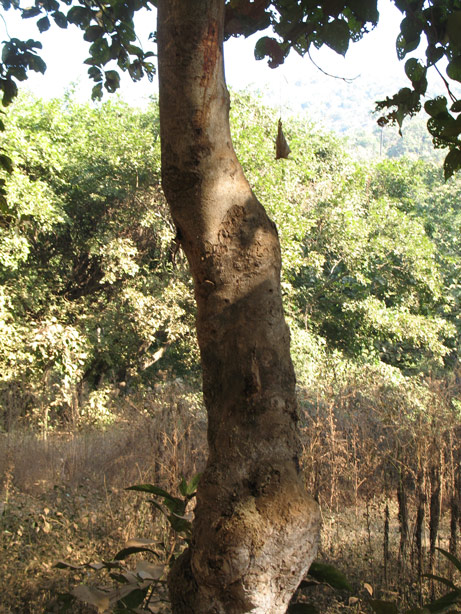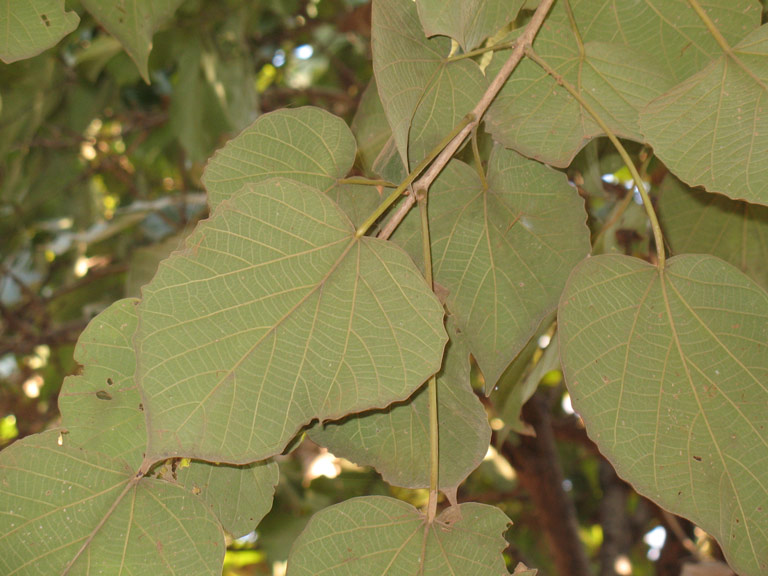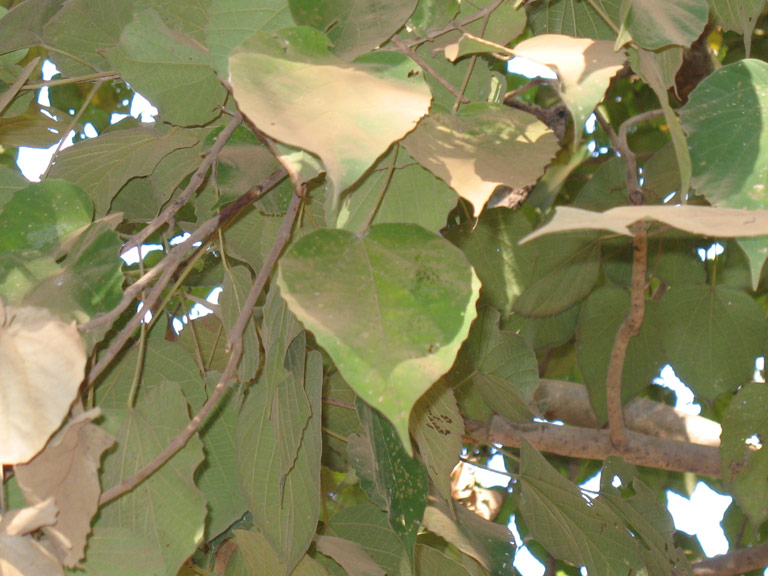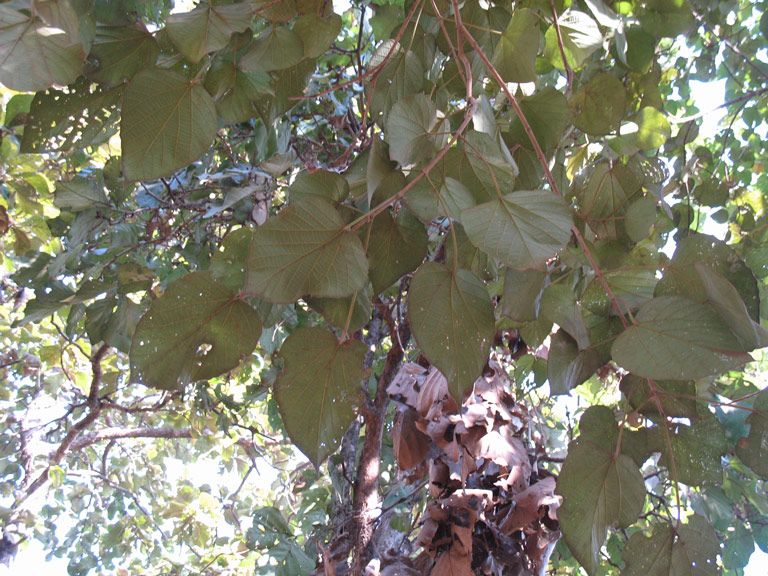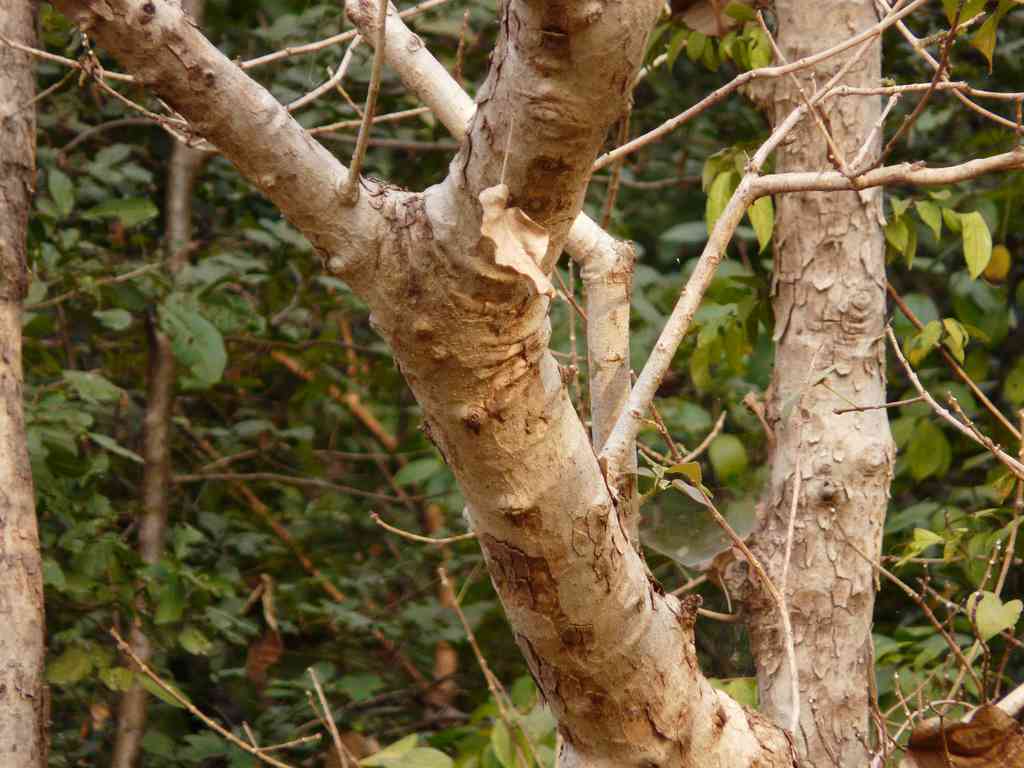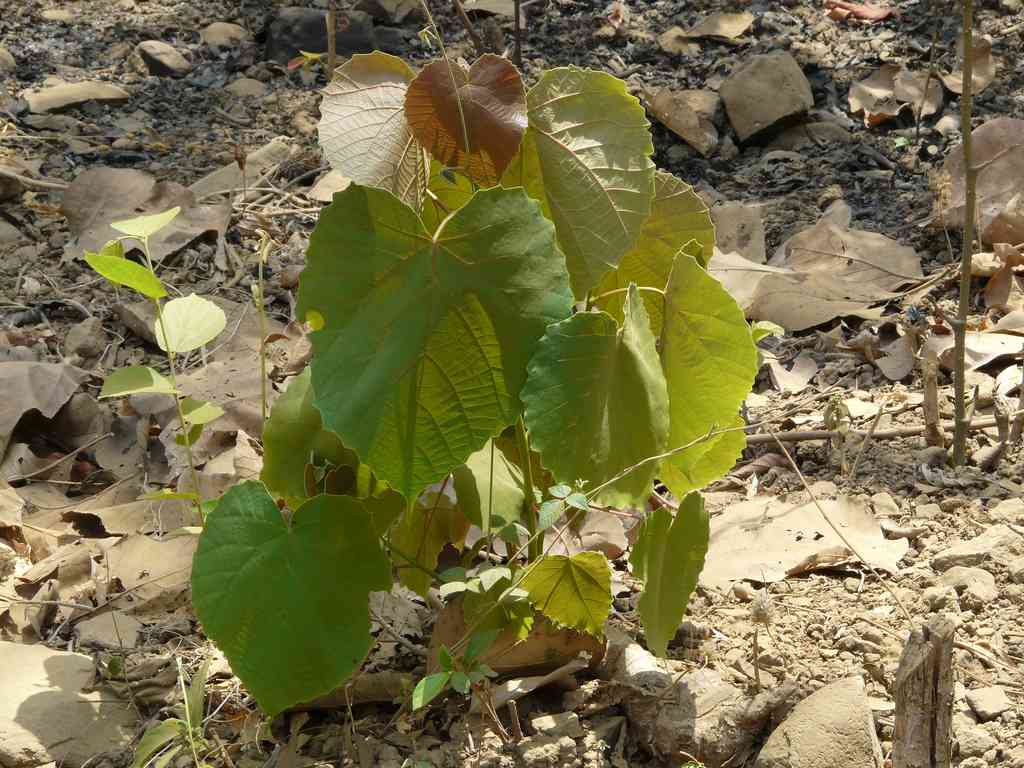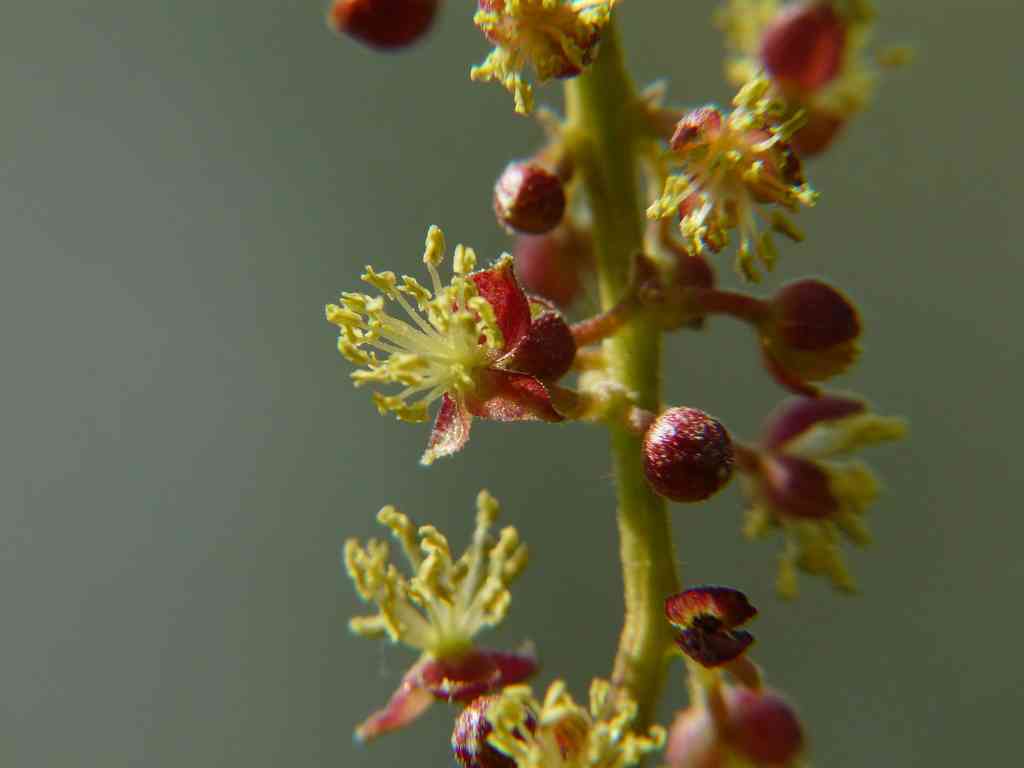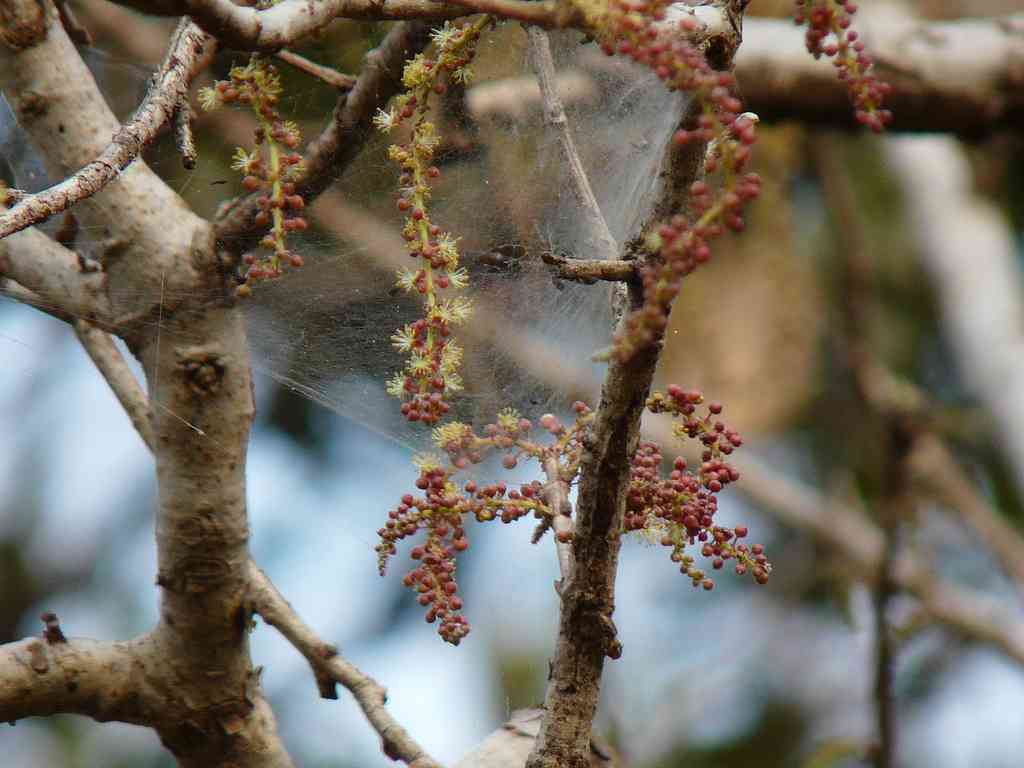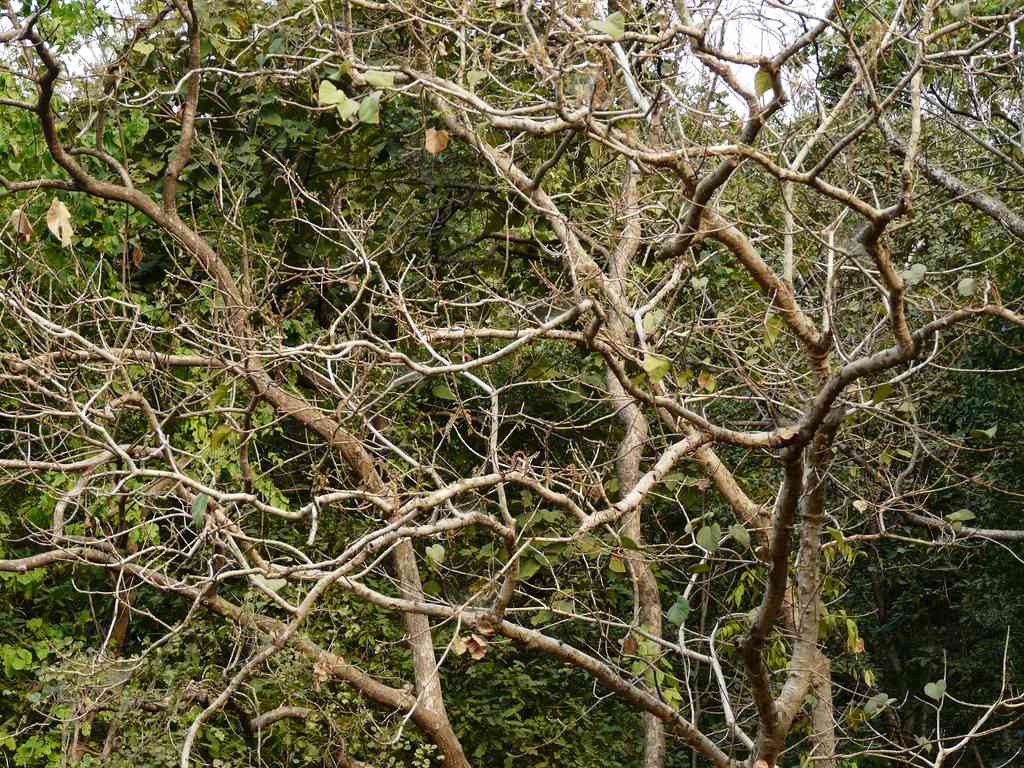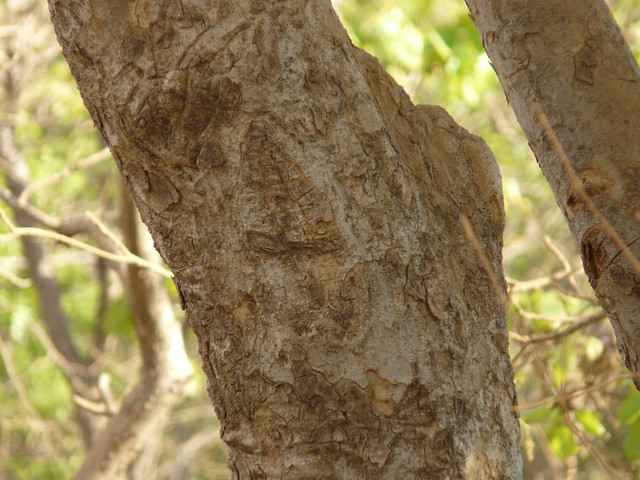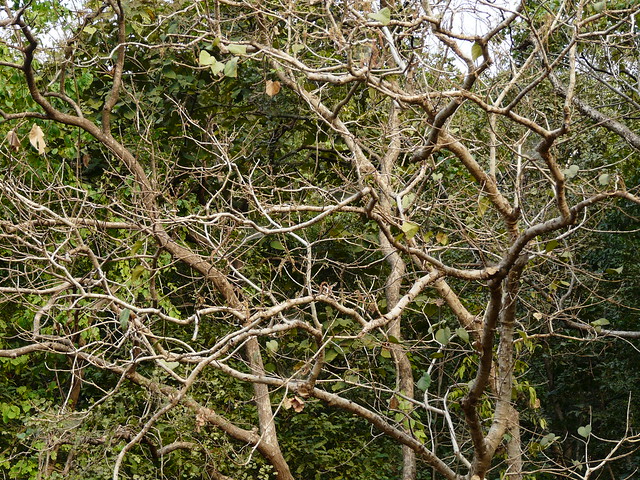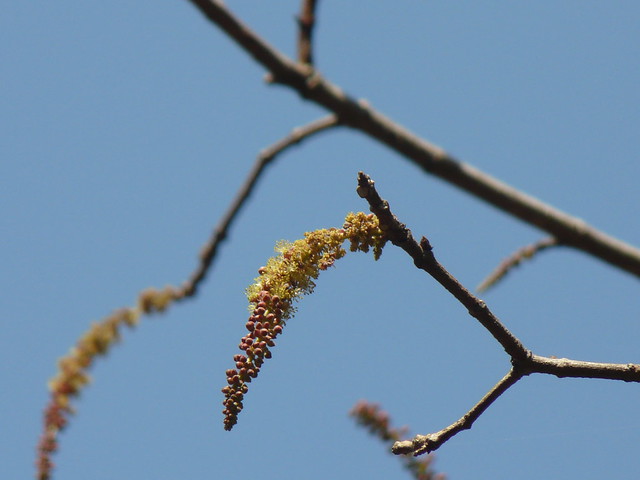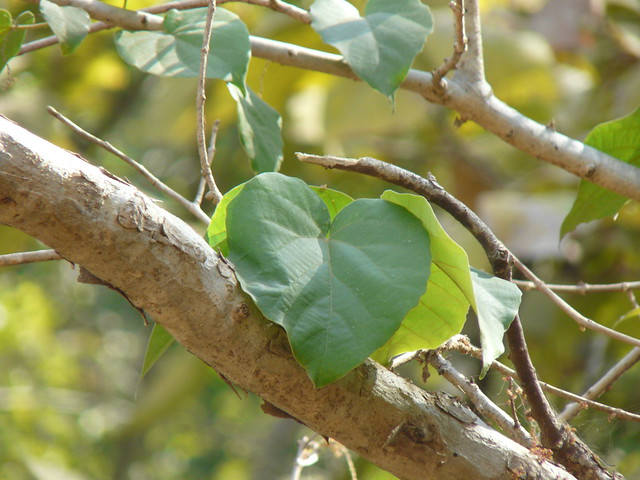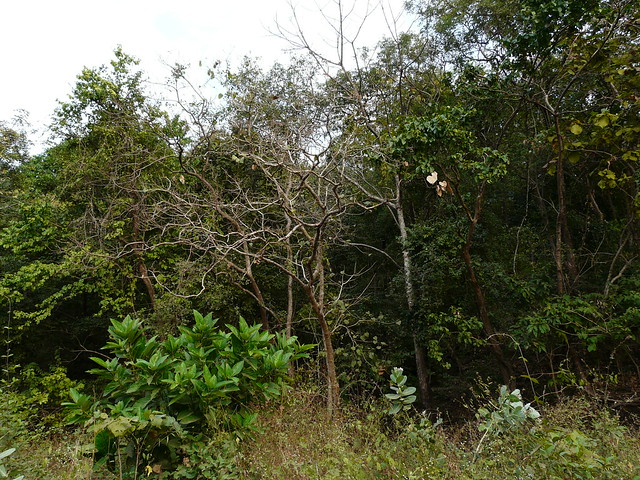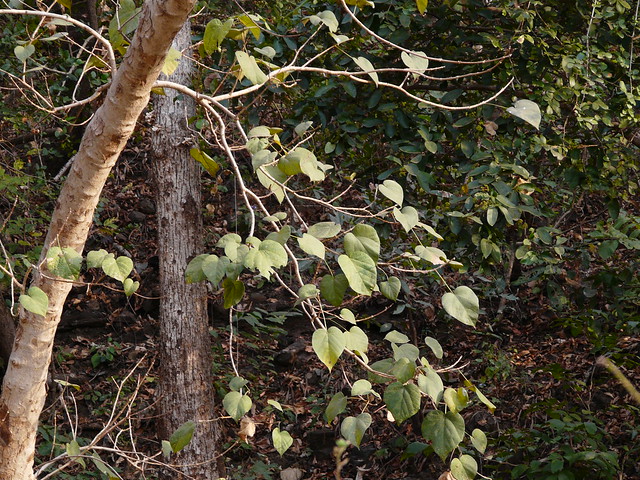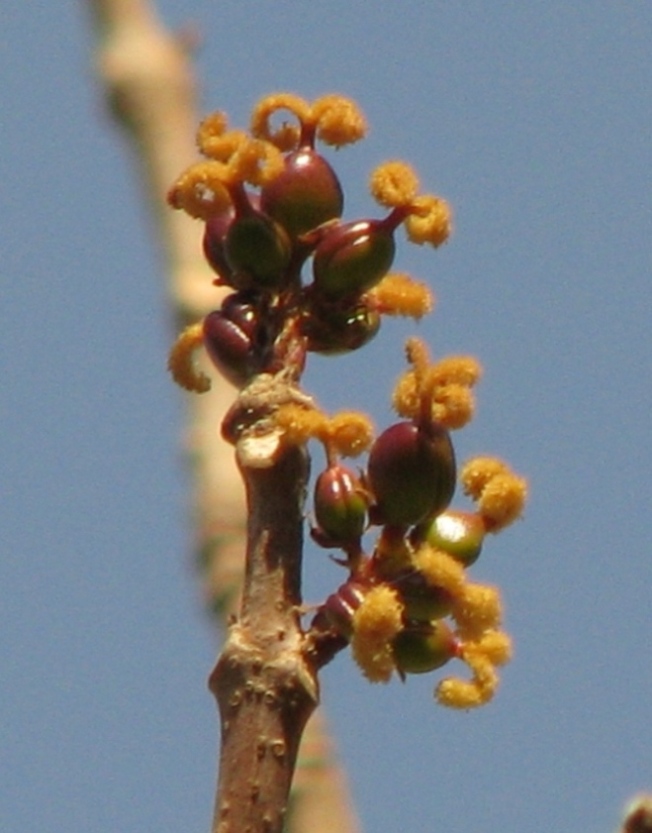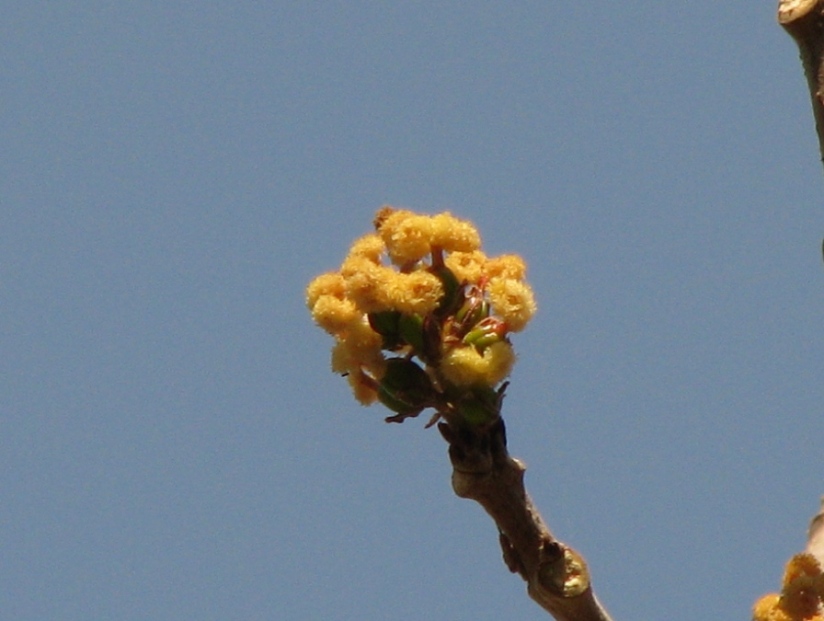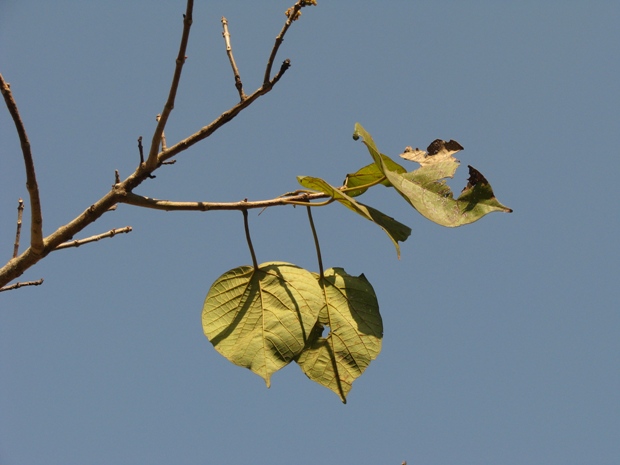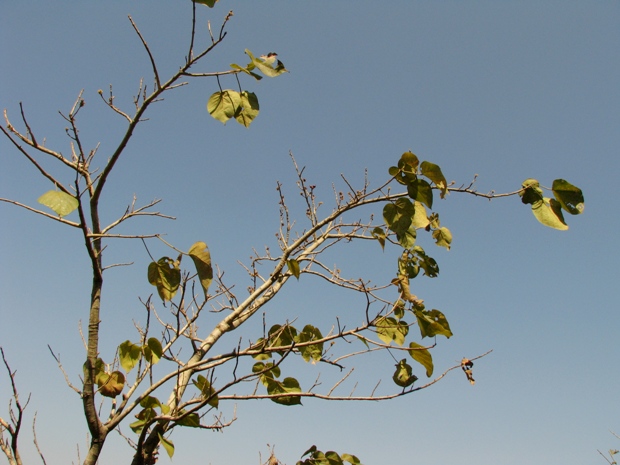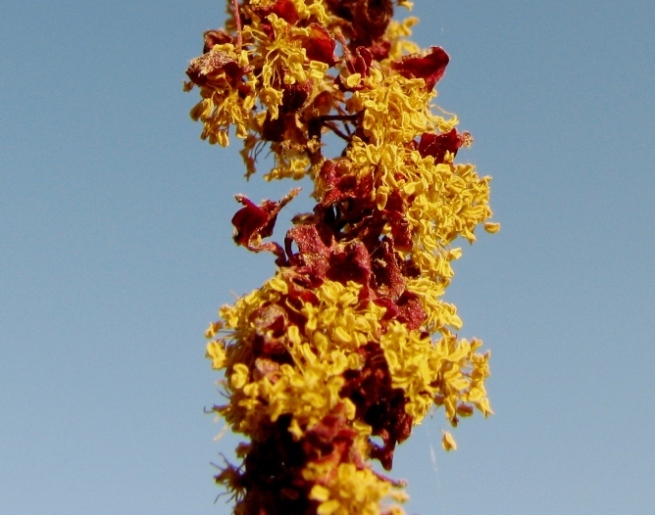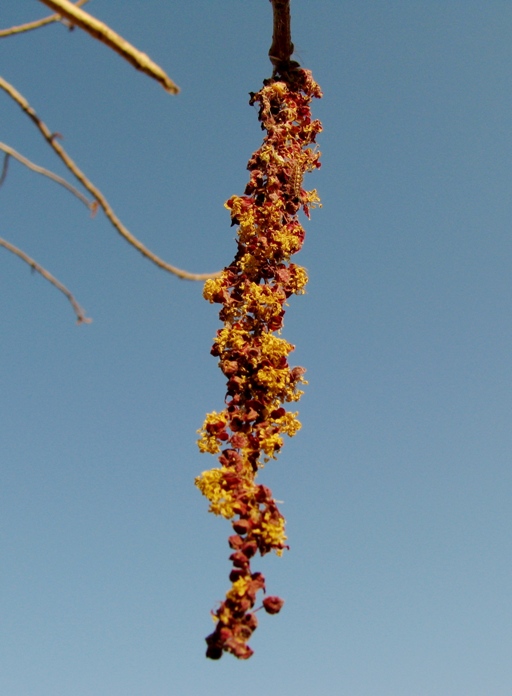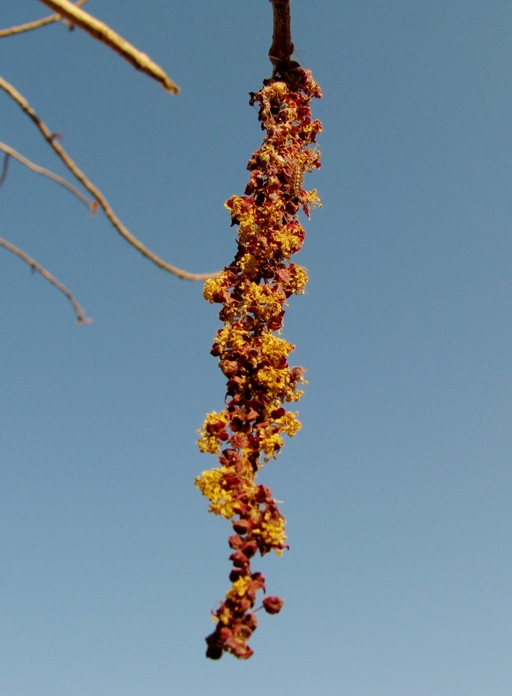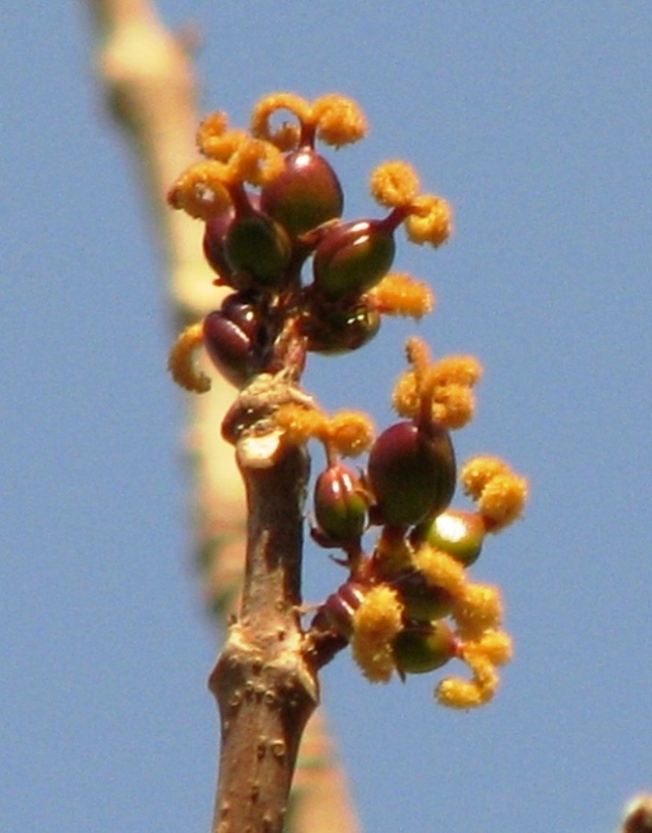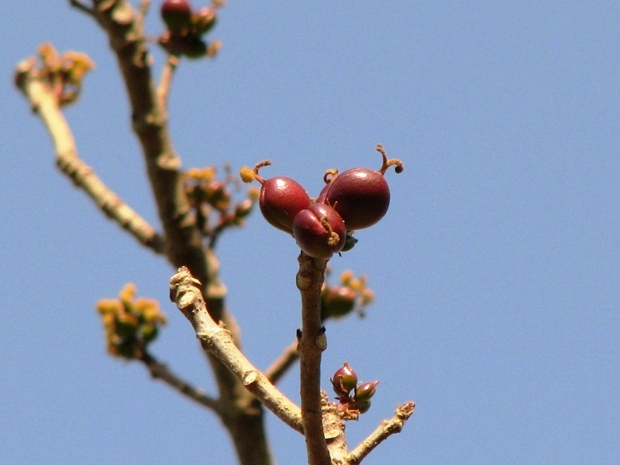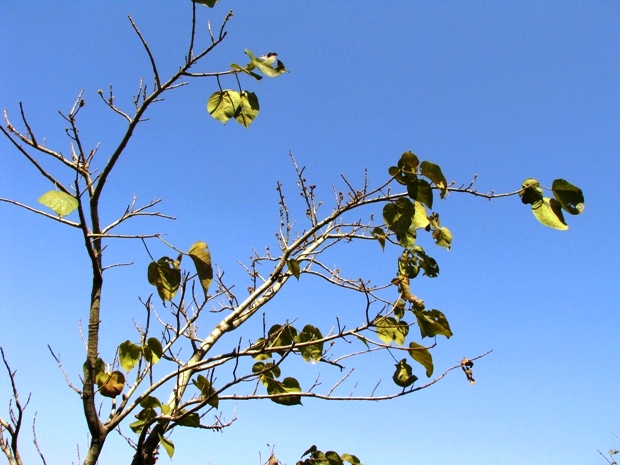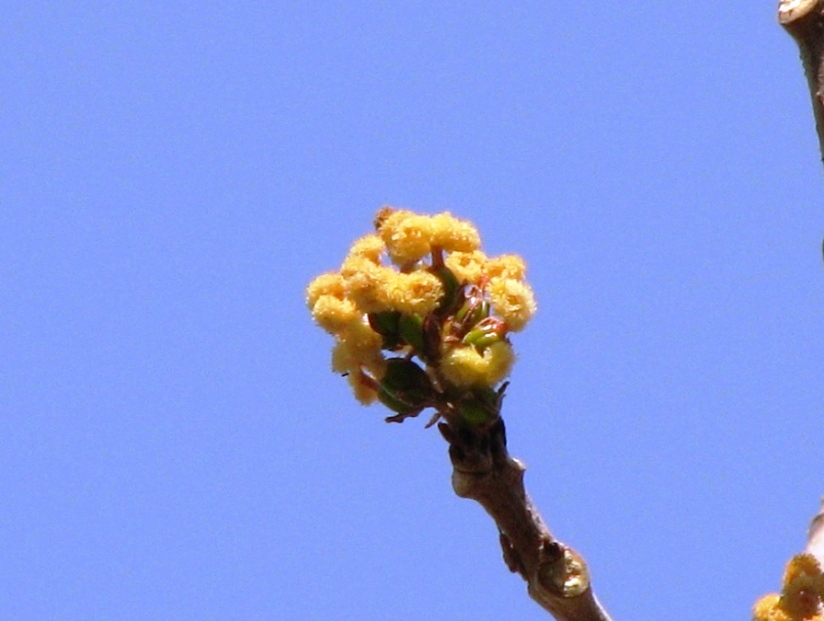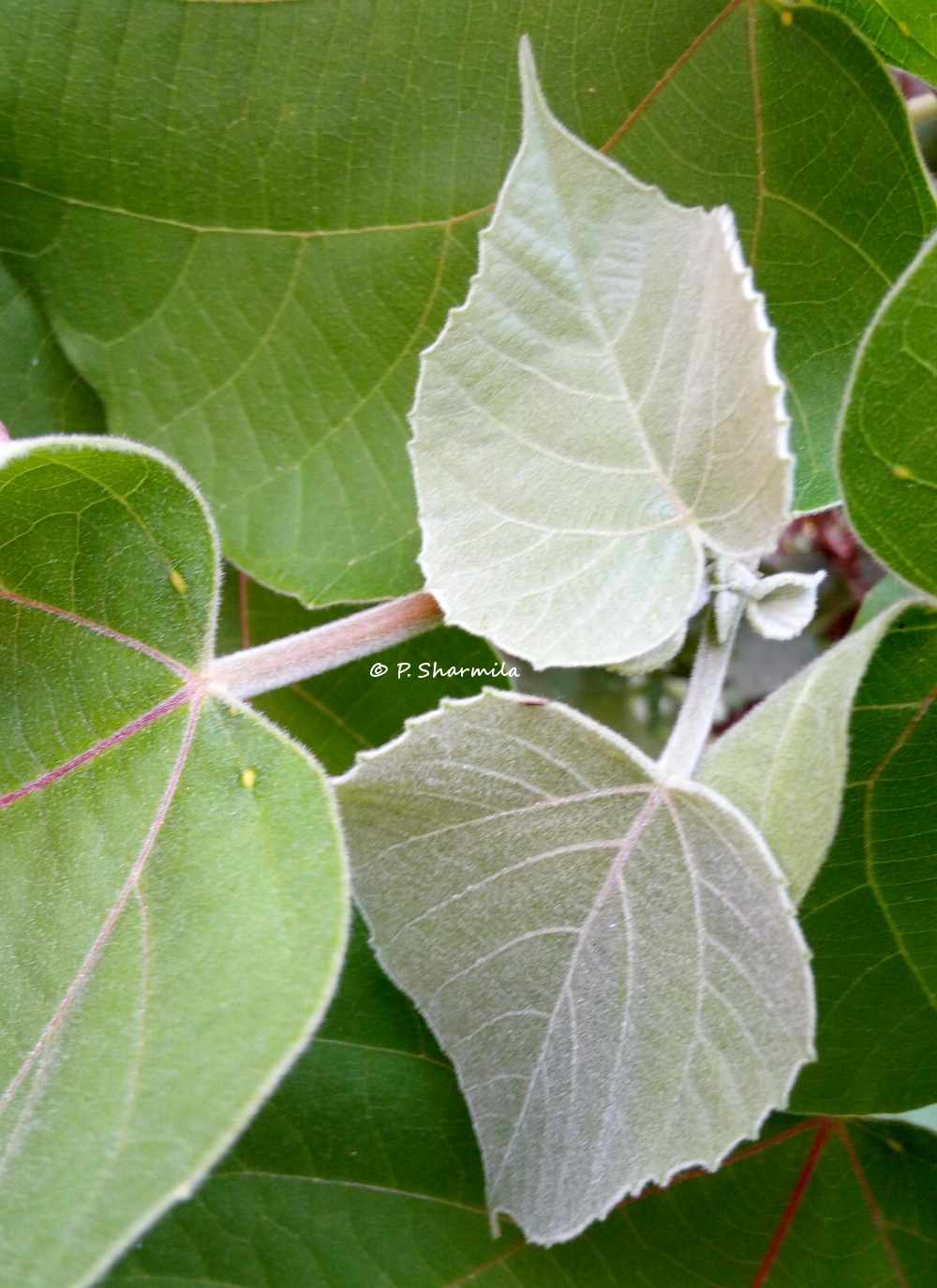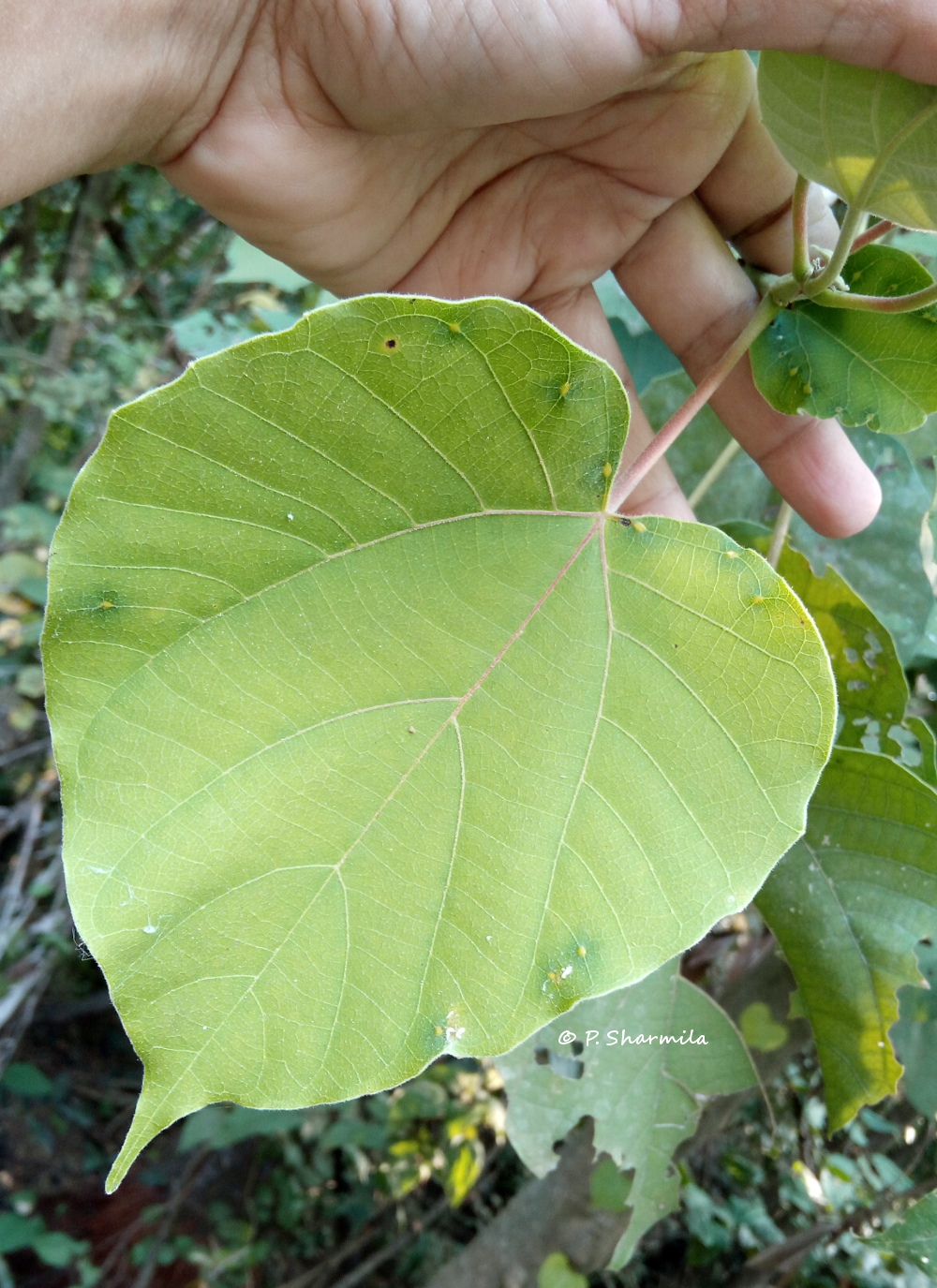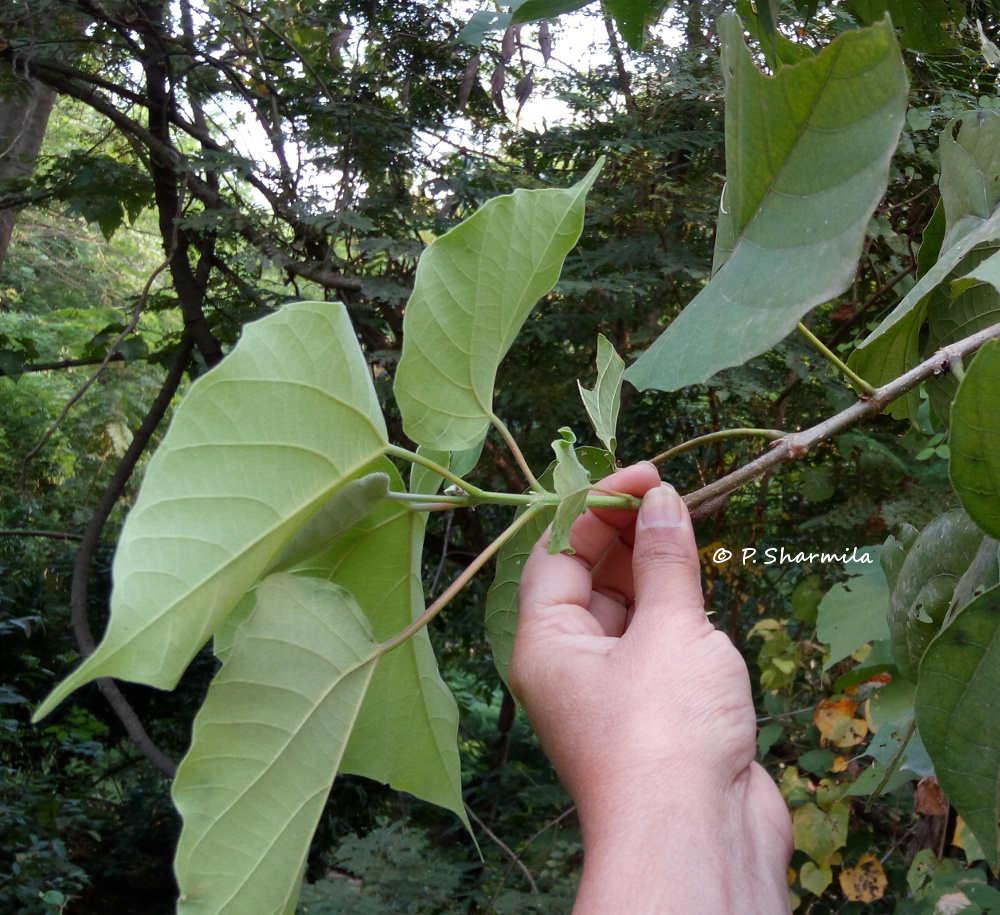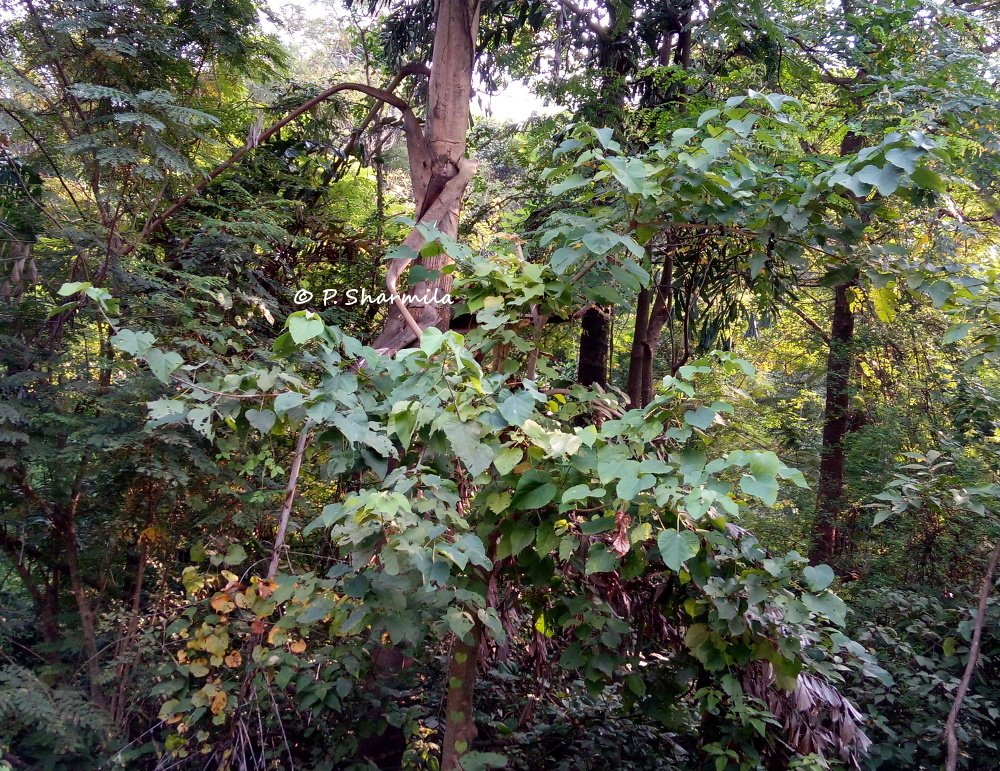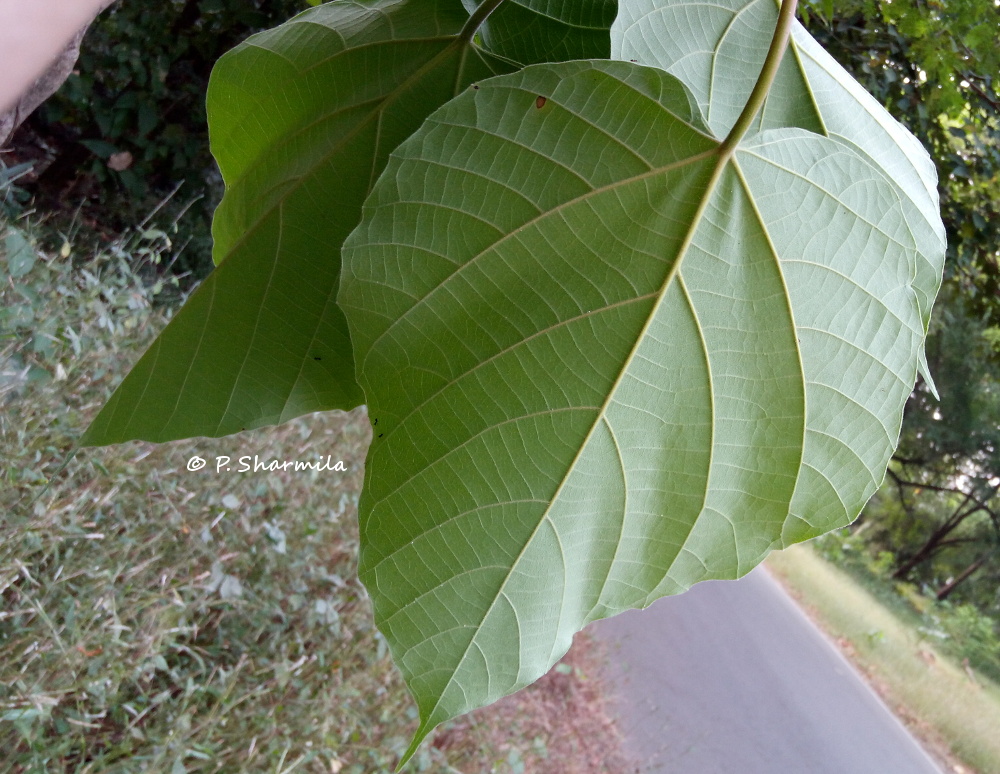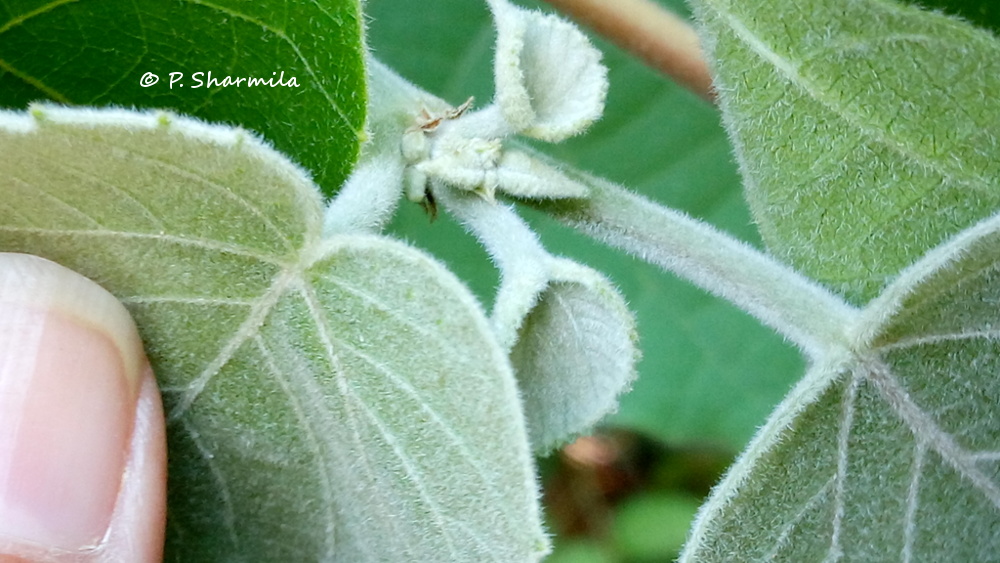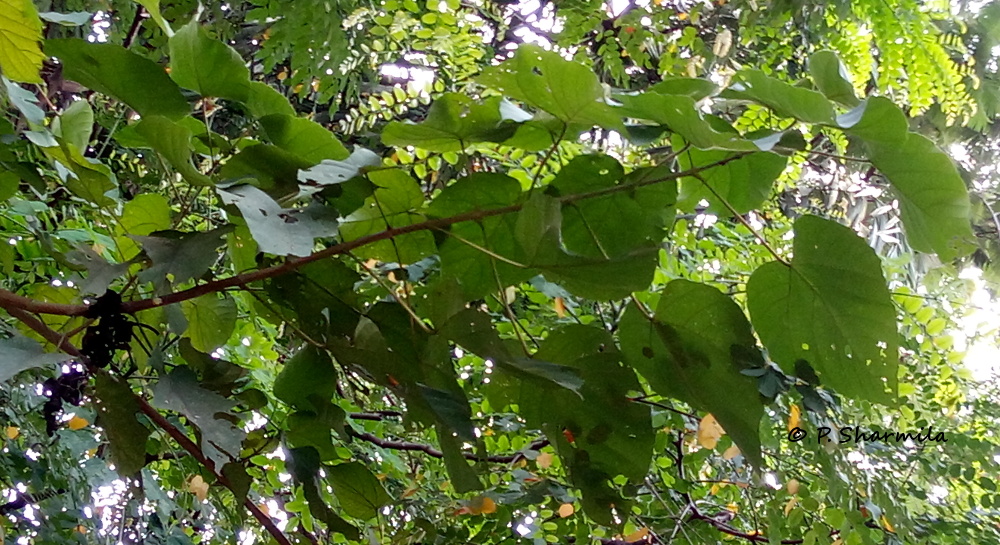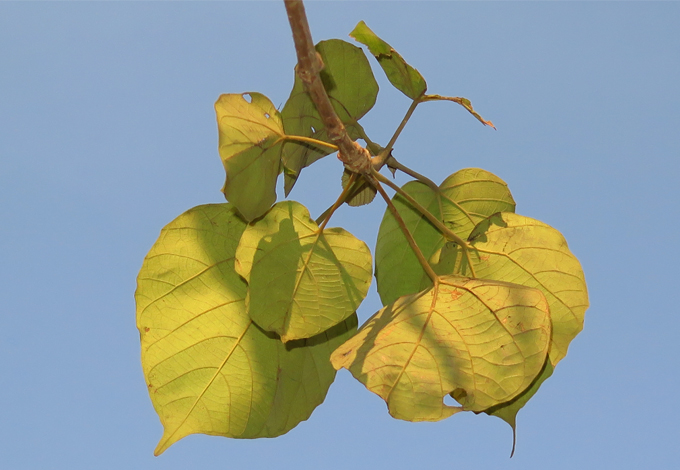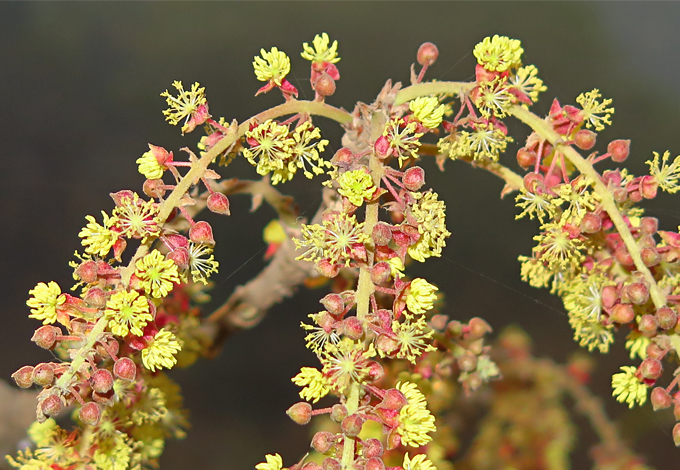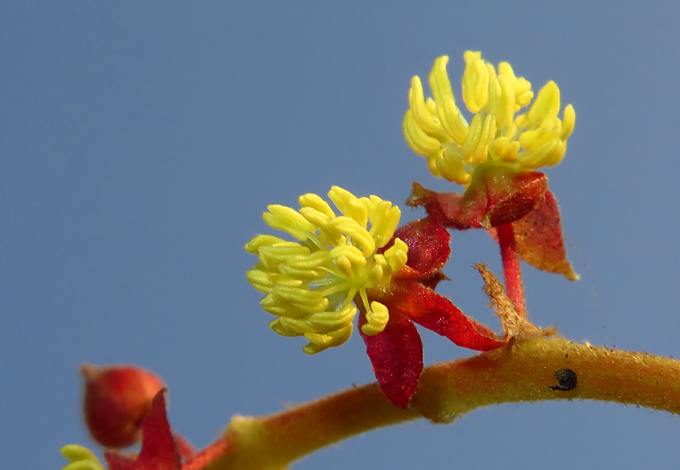Mallotus polycarpus (Benth.) Kulju & Welzen, Blumea 52: 130 2007. (Syn: Trewia nudiflora var. polycarpa (Benth.) Susila & N.P.Balakr.; Trewia polycarpa Benth.); . Fruit 3 cm, globose, not splitting …….T. nudiflorus Fruit 1 cm, ovoid, outer shell thin, splitting……………..T. polycarpus Male flowering plants identical in both sp. Female flowers solitary in nudiflora and racemose in polycarpa. . As per efi thread: Male flowers have red calyx here (in M. polycarpus), whereas M. nudiflorus male flowers have greenish calyx. . Tree ID request – RK75 – 29-Dec-2012: It looks like Trewia polycarpa It looks like Trevia nudiflora var. polycarpa Trevia nudiflora L., Sp. Pl. 1193. 1753; Müll.Arg. in DC., Prodr. 15(2): 953. 1866; Hook.f., Fl. Brit. India 423. 1887. Mallotus nudiflorus (L.) Kulju & Welzen, Blumea 52: 124. 2007 KEY TO THE VARIETIES 1a. Leaves, inflorescences and fruits glabrous 2 b. Leaves, inflorescences and fruits tomentose or pubescent 3 2a. Fruits 2 – 3.5 cm across, with very thick pericarp 1.2. var. nudiflora b. Fruits 1 – 1.5 cm across, with very thin pericarp 1.3. var. polycarpa 3a. Branchlets densely flocculent-cottony or woolly-tomentose; leaves entire along margins; fruits 2 – 3 cm across, densely white-cottony tomentose 1.4. var. tomentosa b. Branchlets softly pubescent; leaves dentate along margins; fruits 1.5 – 1.8 cm across, yellow pubescent 1.1. var. dentata 1.3. var. polycarpa (Benth.) Susila & N.P.Balakr. in J. Econ. Taxon. Bot. 22: 351, f. 2. 1998. Trevia polycarpaBenth. in Benth. & Hook.f., Gen. Pl. 3: 318. 1880; Hook.f., Fl. Brit. India 5: 424. 1887, p. p. Mallotus polycarpus (Benth.) Kulju & Welzen, Blumea 52: 130. 2007. Kan.: Bomvaro, Tumri; Mal.: Pambara–kumbil; Mar.: Petari; Tam.: Anathuvarei, Kaanji, Raajni. Fl.& Fr. Mar. – Oct. Distrib. India: In evergreen forests, along hill slopes and river and stream banks, up to 1200 m altitude. Madhya Pradesh, Maharashtra, Goa, Karnataka, Kerala and Tamil Nadu. Very common in N. Kanara in Karnataka and Goa. Endemic. Copied and pasted from our unpublished work.
I am sure this key will be very helpful all around, and thanks for the citation reference, appreciate it. As i was reading this thread i remember my Rauvolfia serpentina post, relating the correct use of “w” or “v”. And, i want to know if Trevia nudiflora L. and Trewia nudiflora L. are same species. According to The Plant List they are not, and …, many a time, pointed out the ambiguities in The Plant List. You may find the following links very interesting reading – Book link one, two and three I didn’t know there was no “w” in the classical Latin alphabet! ………………………….. Ref: Nationaal Herbarium We, in our treatment of Flora of India, do not agree that Trevia is a synonym of Mallotus. We consider it to be a distinct genus. Thank you Sir, i have noticed that The Flora of China also maintains two distinct pages for Trevia and Mallotus. Taxonomy is a personal opinion. No one stops you in believing what you want to believe. I still dont agree with Asclepiadaceae merging with Apocyanaceae but many do. Thank you very much … The link seems to be the same what i copy-pasted in my Trewia post, last year – efi thread The Plant List may be pardoned for this and many other confusions. To me the Flora of China (2008) position in maintaining Trevia nudiflora L. and seems most logical: Kulju et al. (Blumea 52: 115–136. 2007) showed that Trevia is embedded within Mallotus, from which it differs only by the indehiscent fruit, and they transferred it to that genus, along with T. polycarpa Bentham, which they regarded as distinct. However, the name Trevia (1753) has priority over Mallotus (1790). For the sake of nomenclatural continuity, Mallotus should be formally conserved against Trevia because the former name is better known and has traditionally been applied to a much larger genus than the latter. The alternative would be many new combinations in Trevia. We are maintaining here the name Mallotus, which applies to a very easily recognized entity, until this nomenclatural issue is resolved” I was searching my hard-disk for female flower of Trevia nudiflora L. I attach here pictures of the female flower that i think is T. nudiflora L. Thank you very much for explaining the confusion between Trewia and Trevia and their relation to Mallotus. Thank you so much… for sharing this data from your work. I am really grateful. If I understand correctly, the difference between the varieties nudiflora and polycarpa is in the characteristics of the fruit. I am wondering if it is possible to identify the variety in the absence of flowers and fruits. The immature leaves of the 2 species are fairly similar and difficult to distinguish. Both sometimes have the dentate margins and vary in the amount of pubescence. They also vary greatly in size and shape. I was thinking again about these 2 species which have often been confused. This is partly because the marathi name Petari is used for both. . Euphorbiaceae fortnight :: Trevia ≠ Mallotus :: DV71 : 1 post by 1 author. Trevia ≠ Mallotus … comment in … post dated 29 DEC 12 … Tree ID request – RK75 – 29-Dec-2012 We, in our treatment of Flora of India, do not agree that Trevia is a synonym of Mallotus. We consider it to be a distinct genus. Tree for ID : 26032013: RV 3 : 10 posts by 6 authors. Request ID of another tree………picture taken today…..tree is about 12 to 15 ft tall, without leaves. This is Petari / Petani [Trewia nudiflora]. Agree with … Nice picture of the inflorescence. What is the location ? the picture is taken yesterday (26.3.13) on Silonda trail of Borivali National park, Mumbai. In that case it is most likely Trewia polycarpa. Nice photographs. You may post the pictures of foliage when the leaves reappear in due course Thanks …, yes I hope to get the pictures of foliage as well the fruits. since male and female flowers are on separate plants and males are in a raceme inflorescence whereas females are few on a peduncle… this must be a male tree and we will not see any fruits on it!…sad for me and Renee were going again to check the fruits…now we will check the leaves ! The picture in File 1 has been identified as Trewia nudiflora earlier which was taken on 24th April in SGNP, Mumbai. The white aril on the seed are edible and fairly sweet in taste. The picture in File 2 has been taken today, also in SGNP, Mumbai……seems like some specie of Trewia ? Fruit is much larger then the the fruit of Trewia nudiflora and the aril on the seeds are not at all palatable. This tree was about 60 to 70 ft tall Both the trees are fruiting profusely. Please help to solve the id of these beautiful trees. Aleurites moluccana is my guess… For me the plant looks more like Trewia species only. Both seem Trewia species. The difference in the 2 sp is as below. Fruit 3 cm, globose, not splitting …….T. nudiflora Fruit 1 cm, ovoid, outer shell thin, splitting……………..T. polycarpa Male flowering plants identical in both sp. Female flowers solitary in nudiflora and racemose in polycarpa. Leaves and may differ but not characteristic. You have not mentioned the sizes of the fruits but as per above File 1 seems T. polycarpa and File 2 seems T. nudiflora provided sizes tally. SGNP has both species of Trewia. Petari – fruits and flowers : Attachments (10). 3 posts by 1 author. It is not Mallotus nudiflorus (L.) Kulju & Welzen synonym of Trevia nudiflora L. var. nudiflora (Benth.) Susila & N.P. Balakr. … my mistake in identification. Please know this plant as Trevia polycarpa Benth. synonym of Trevia nudiflora L. var. polycarpa (Benth.) Susila & N.P. Balakr. Euphorbiaceae fortnight :: Trevia polycarpa in Tungareshwar WLS :: DV73 : 10 images. 9 posts by 5 authors. Trevia nudiflora L. var. polycarpa (Benth.) Susila & N.P. Balakr. … popular synonym: Trevia polycarpa Benth. Dear friends, this post shows sightings of plants which I had mistaken for a very long while as Mallotus nudiflorus (Trevia nudiflora var. nudiflora). sightings at Tungareshwar Wildlife Sanctuary during different times the tell-tale dark pink calyx / buds, easily made out even on top-most branches; in case of Trevia nudiflora var. nudiflora the calyx are yellowish-green the fruit has pronounced cleft, the fruits are borne in cluster; in case of Trevia nudiflora var. nudiflora, the fruit has very subtle cleft, the fruit is borne solitary or to a maximum of three. the leaves are heart-shaped, as broad as long; in case of Trevia nudiflora var. nudiflora, the leaf is longer than wide. thank you for bringing such clarity to this topic with your pictures.
This tree was seen on the way to Matheran Hill. Trevia nudiflora. …, I have seen this dark pink fruited trees in northern Western Ghats for quite a long time, I am familiar with its size – just about 15 mm, with a deep longitudinal cleft; the fruits are in clusters of more than 3 in number. … may not be aware OR has missed writing the approx dimension of the fruit. I am of the strong belief that this plant is T. polycarpa (T. nudiflora var. polycarpa). I fully agree with … Trevia nudiflora L., Sp. Pl. 1193. 1753; Müll.Arg. in DC., Prodr. 15(2): 953. 1866; Hook.f., Fl. Brit. India 423. 1887. Mallotus nudiflorus (L.) Kulju & Welzen, Blumea 52: 124. 2007 Asm.: Bhel-kol, Kenlo, Pithakuma-kendlow; Beng.: Paringambhar, Pitali; Garo: Arurong, Boinokhap, Bol-diktak, Joingheia; Hindi: Bhillaru, Gambhar, Pindara, Tumri; Kan.: Kaadukayi, Katkumbala; Kh.: Dieng-soh-lyndot; Lep.: Thungplam; Mal.: Kattu-kumi, Mala-kumi, Pambara-kumbil; Mar.: Petari; Nep.: Aule-kapase, Belar, Gamari, Garum, Kurong, Pitali, Ramrita; Or.: Monda, Pithaliya-panijambhar; Tam.: Annathuvarei, Attarasu, Attu-puvarasu, Raypkunul; Tel.: Eruponaku; Urdu: Mondu. Trees, dioecious, deciduous, 7 – 20 m tall. Leaves opposite, broadly ovate to deltoid, truncate or cordate at base, entire or dentate along margins, acuminate to cuspidate at apex, 6 – 20 x 3 – 15 cm, chartaceous, glabrous above, velutinous beneath; basal nerves 3; lateral nerves 3 – 6 pairs; petioles of each node unequal, 3 – 10 cm long; stipules linear, 2 – 4 x 1 – 2 mm, caducous. Inflorescences precocious. Male flowers: greenish, in 2 or 3-flowered clusters on axillary or terminal lax pendulous 8 – 16 cm long racemes; bracts ovate-lanceolate, ca 3 mm across; pedicels 3 – 5 mm long; sepals 3 or 4, ovate, concave, 3.5 – 6 x 2 – 4 mm; stamens 20 -25; filaments free, 1.5 – 2.5 mm long; anthers oblong, 1 – 1.5 x 0.5 – 0.7 mm. Female flowers: axillary, solitary or in 5 – 15 cm long stout racemes; pedicels 5 – 9 mm long; sepals 3 – 5, broadly ovate, 4 – 5 mm long, densely woolly tomentose outside, caducous; ovary 3 – 5-loculed, 3 – 4 mm across, tomentose; styles 3 – 5, shortly connate at base, 1.5 – 3 cm long. Fruits 2 – 5-loculed, ovoid to subglobose, 1- 3.5 cm across, shallowly lobed, dehiscent or apparently indehiscent, fleshy, becoming woody with thick or thin pericarp, densely pubescent to glabrous; seeds 3 – 5, globose to ovoid, 0.5 – 1.3 cm across. KEY TO THE VARIETIES 1a. Leaves, inflorescences and fruits glabrous 2 b. Leaves, inflorescences and fruits tomentose or pubescent 3 2a. Fruits 2 – 3.5 cm across, with very thick pericarp 1.2. var. nudiflora b. Fruits 1 – 1.5 cm across, with very thin pericarp 1.3. var. polycarpa 3a. Branchlets densely flocculent-cottony or woolly-tomentose; leaves entire along margins; fruits 2 – 3 cm across, densely white-cottony tomentose 1.4. var. tomentosa b. Branchlets softly pubescent; leaves dentate along margins; fruits 1.5 – 1.8 cm across, yellow pubescent 1.1. var. dentata 1.1. var. dentata Susila & N.P.Balakr. in J. Econ. Taxon. Bot. 22: 352, f. 4. 1998. Fl. & Fr. March – Sept. Distrib. India: Evergreen florets, along riverbanks and stream sides, up to 1200 m altitude. Maharashtra. Endemic. 1.2. var. nudiflora Fig. 29 Fl. & Fr. Feb. – Aug. Distrib. India: Tropical and subtropical forests, often along riverbanks and stream sides, up to 1000 m altitude. Uttar Pradesh, Bihar, West Bengal, Sikkim, Assam, Tripura, Meghalaya, Orissa, Madhya Pradesh, Andhra Pradesh, Maharashtra, Karnataka, Kerala and Tamil Nadu. Sri Lanka, Nepal, Bhutan. Bangladesh, Myanmar, S. China, Indo-china, Thailand to Malesia. Uses. Leaves are used as cattle fodder. Wood soft, used for carving, planking, in match industry, packing cases and plywood. The fruit pulp is sweet and edible. Notes. Chromosome number: 2n = 22 (Bhaduri & Kar, Proc. Indian Sci. Congr. 36th Session, Part 3: 140. 1949; Datta, Taxon 16: 341 – 350. 1967; Hans, Taxon 22: 591 – 636. 1973). The leaves are similar to those of Gmelina arborea. 1.3. var. polycarpa (Benth.) Susila & N.P.Balakr. in J. Econ. Taxon. Bot. 22: 351, f. 2. 1998. Trevia polycarpaBenth. in Benth. & Hook.f., Gen. Pl. 3: 318. 1880; Hook.f., Fl. Brit. India 5: 424. 1887, p. p. Mallotus polycarpus (Benth.) Kulju & Welzen, Blumea 52: 130. 2007. Kan.: Bomvaro, Tumri; Mal.: Pambara-kumbil; Mar.: Petari; Tam.: Anathuvarei, Kaanji, Raajni. Fl.& Fr. Mar. – Oct. Distrib. India: In evergreen forests, along hill slopes and river and stream banks, up to 1200 m altitude. Madhya Pradesh, Maharashtra, Goa, Karnataka, Kerala and Tamil Nadu. Very common in N. Kanara in Karnataka and Goa. Endemic. 1.4. var. tomentosa Susila & N.P.Balakr. in J. Econ. Taxon. Bot. 22: 351, f.3. 1998. Fl. & Fr. Jan. – July. Distrib. India: Evergreen or semievergreen forests, up to 1200 m altitude. Sikkim, West Bengal, Tripura, Orissa, Andhra Pradesh, Maharashtra and Gujarat. Bangladesh, Myanmar, Indo-china and Thailand. Now try to find the differences of the variable species. If variation is good, you can propose it as a new variety. Euphorbiaceae fortnight :: Trewia nudiflora male flowers?? from Matheran region :: PKA45: : Attachments (3). 6 posts by 4 authors. Seen this tree on the way to Matheran Hill. Without leaves I can not say. With the familiarity of watching these inflorescences with dark pink calyces, would say this plant is T. polycarpa … (T, nudiflora var. polycarpa). I support … The male flowers with red calyx are T. polycarpa. Date/Time: 19-02-2011 / 08:50AM – this looks to me … Mallotus nudiflorus (popular synonym: Trewia nudiflora) … the tree must have caught on with some kind of infection. – It is male flowers of the same i.e. Trewia nudiflora This is Mallotus polycarpus. Male flowers have red calyx here, whereas M. nudiflorus male flowers have greenish calyx.
Trewia nudiflora : Attachments (4). 4 posts by 4 authors. Trewia nudiflora. Trewia polycarpa as per another thread by … Here is the thread link. ……………… Thanks very much … for updating this thread. . Date/Time: 19-02-2011 / 11:50AM Habitat: Wild Plant Habit: Tree … to me looks like Mallotus nudiflorus (syn. Trewia nudiflora) … I think … is absolutely correct this plant is indeed Mallotus nudiflorus The leaves appears to belong to Trewia nudiflora L., but the flowers and fruits not matching. Please see my earlier postings of T.nudiflora L. here I think the leaves also do not belong to T. nudiflora. There is a distinct front venation of the leaves in T. nudiflora and not as cordate as seen in the pictures. Agree with …. This does not look like Trewia nudiflora. Sending a link to my photographs of T.nudiflora for comparison. efi thread I appreciate your keen observation. I am seeing pictures of this (female) tree for the first time but can say that this is female plant of T. nudiflora. Globose woody fruits with 3 yellow styles can be seen on long stout peduncles. The leaves also tally though .. and … seem to differ. The other tree posted in another post is a male tree of the same sp. clearly showing flowers with stamens in pedulous racemes. The female tree is fruiting so the male tree had to be around, good you got both together. Why not search for another Trewia polycarpa which has female flowers in racemes and the fruits are 8 mm, ovoid instead of 3 cm, globose as in T. nudiflora. I have been searching for this tree for last several years. Keep it up. Just to put things in perspective. The leaves of … tree dont look anything like this. … my belief (could be wrong) … leaves of young tree (or sapling) of Trewia nudiflora look like this … matured tree does not show leaves in the same fashion. You could be right, but the first photograph is of a 25 – 30 ft. tall tree. … I am not familiar with Trewia polycarpa, will not stress on T. nudiflora. Agree with … This is Trewia nudiflora, now Mallotus nudiflora. Trewia polycarpa as per another thread by … …………….. Thanks very much … for updating this thread. Thank you very much … for the key to the 4 varieties of Trevia nudiflora. Yes, the plant posted by …, is for certain, T. polycarpa (T. nudiflora var. polycarpa). Fruits (seen here in typical dark red colour, with the tell-tale strong cleft), of size 1.5 cm, in clusters. Images of Givotia rottleriformis Griff. (Euphorbiaceae) : 6 posts by 3 authors. Attachments (5) I am attaching herewith a few images of Givotia rottleriformis found by us as a deciduous tree, 8 – 10 m high, on a hillock in the outskirts of Pune, Maharashtra. Photographs by the courtesy of Mr. A. M. Gokhale Thanks, … Similar photos in EFI are listed under some Malotus nudiflora var….. . If you are correct, those have to be corrected. I am confused with this observation. I recognize the fruits and leaves from the posted pictures as Trevia nudiflora L. var. polycarpa (Benth.) Susila & N.P. Balakr. I have seen such trees in Tungareshwar WLS (now part of Sanjay Gandhi National Park). Oops.. I am so sorry. I posted wrong set of images. This post may be deleted immediately. Heart shaped lobbed leave Tree Id at SGNP : 4 posts by 3 authors. Attachments (8) Please find attached pictures of a tree. Please help id this tree. Location: Sanjay Gandhi National Park, Mumbai Date: 27-Oct-2018. Phyllotaxy: Opposite, decussate. Leaf: Simple with auxiliary vegetative buds. Old leaves are bit wooly, hairy. Young leaves are very wooly with white hairs. Hairs are not itchy. Leaf Margin: Bit wavy, Scalloped. Leaf Shape: Cordate, large. Leaf Apex: Acuminate. Venation: Unicostate, Reticulate. Petiole: Petiolate. Stem: Young stem has white small hair. Stipule: No Stipules found. Must be Trevia nudiflora var. polycarpa. great. leaf matches exactly what Dinesh has on his flickeriver site scroll down to the bottom of page. seems the leaf veins are eye-catching. not sure if its unique, but to me they are memorable. Many Thanks …! Leaf shape, underside and upperside of leaf, vein’s pinkish colour, leaf margin, phyllotaxy matches. Young leaf colour, and leaves woolyness is bit different, but with respect to variation depending on climate, season and habitat the overall species is matching. Not much aware of but the woolyness and color of young leaves can be different depending on insect’s availability as trees are always aware that rainy season have more insects than in march, april. Please comment. It is just like Sita Ashok has prominent nectar glands on leaves in forest than in cultivated area. Sorry to mention that new google interface keep shooting mail before validating due to some active key pressed which am not aware of. It happened two three times. The “Leaf Margin: Entire, Bit wavy, Scalloped” should have been “Leaf Margin: Bit wavy, Scalloped”. And Subject line should have been “Heart shaped leave Tree Id at SGNP”. Sorry, too many mosquitos were around when mailed yesterday so could not correct at the same time. Goa, May 2019 :: Shrub for ID :: ARK2019-34 : 3 posts by 2 authors. Attachments (4) Requesting to please ID this shrub captured on a cliff in South Goa May 2019. Seems to be Mallotus polycarpus Tree for Identification from Chinchoti , Maharashtra, Jan -2016 : 4 posts by 3 authors. Attachments (3) Please identify this tree found on roadside height appxt -12 fts. Givotia rottleriformis of Euphorbiaceae. This looks like Trewia nudiflora [now called Mallotus nudiflora] to me. The local name is Petari / Petani. Please check the archives of this group for my photographs of this. Yes …, Mallotus nudiflorus. Thank you for pointing out. This seems to be Mallotus polycarpus. The male flowers have a red calyx. In M. nudiflorus the calyx is greenish. Yes, Mallotus polycarpus, to me too. It is in line with various other posts where M. polycarpus was mistaken for M. nudiflorus. . Small Tree for ID : Way to Nasik : 31MAY22 : AK – 11: 5 images. Mallotus species. Most probably Mallotus polycarpus based on the distribution. . Tamhini ghat near Pune, MH :: Tree for ID :: ARK2025-079: 3 high res. images. Tried but could not reach anywhere. Could it be Mallotus polycarpus ? Just a wild guess looking at the leaves. It looks like it! At left of entrance to Kalubai devrai? Lopped? I remember now seeing small saplings of this in the Cabo de Rama fort in Goa.
. References: |
Mallotus polycarpus
Updated on September 30, 2025

